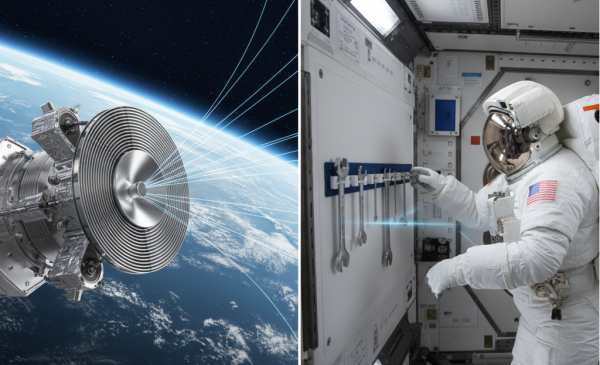Yes, magnets work perfectly fine in space. This straightforward answer addresses a question that captivates many curious minds.
The reason is simple. Magnetism is a fundamental force of nature. Air pressure and gravity don’t affect it, even though these factors are vastly different in space compared to Earth. A magnet’s power to attract or repel comes from within its own material.
This article will guide you through understanding this principle. We’ll explore the basic physics that allow magnets to function in a vacuum. We’ll also clear up common myths and reveal how magnets are essential in space technology. Additionally, we’ll examine the real environmental challenges—like extreme temperatures and radiation—that magnets must survive beyond our world.
Table of Contents
The Fundamental Force
The vacuum of space has no effect on a magnetic field. To understand why, we need to examine what magnetism really is.
Magnetism Inside the Atom
Magnetism starts at the subatomic level. It comes from the movement and quantum spin of electrons. Picture each electron as a tiny spinning top that creates its own small magnetic field.
In most materials, these tiny fields point in random directions. They cancel each other out. However, in magnetic materials like iron, cobalt, and nickel, large groups of these atomic-level magnets can align in the same direction. Scientists call these groups magnetic domains.
When enough of these domains align, their individual fields combine. This creates a larger, visible magnetic field that we can observe and use. This field is a basic property of the material’s structure, not its surroundings.
Debunking Common Myths
Misconceptions often arise from confusing magnetism with forces that do require a medium. Let’s clarify the key differences.
Gravity is one of the four fundamental forces, but it operates completely separately from electromagnetism. A magnet’s pull on a paperclip is an electromagnetic interaction. It works independently of Earth’s gravitational pull. A magnet functions the same way on the International Space Station (ISS) as it does in your kitchen.
A magnetic field is an energy field that extends through space itself. It doesn’t need a medium like air or water to travel. This makes it very different from sound.
- Sound: A mechanical wave that requires a medium (air, water, solids) to travel. It doesn’t work in a vacuum.
- Magnetism: A fundamental field that fills the vacuum of space. It works perfectly in a vacuum.
- Gravity: A fundamental force (or a curvature of spacetime) that also works perfectly in a vacuum.
To learn more about these fields, university resources like MIT OpenCourseWare provide detailed explanations of electromagnetism.
A Tale of Two Fields

A common source of confusion is the difference between a handheld magnet’s field and Earth’s magnetic field. They are related but distinct concepts.
A Magnet’s Own Power
A permanent magnet generates its own self-contained magnetic field. This happens whether it’s a small refrigerator magnet or a powerful motor magnet. The field comes from the alignment of its internal atomic domains.
This field is part of the magnet itself. It travels with the object wherever it goes—across a room or to another planet. Its ability to attract nearby iron is entirely local and self-contained.
Earth’s Giant Shield
Earth also has a magnetic field, but it’s created by a completely different process. The churning of molten iron in our planet’s outer core generates this vast, planet-sized magnetic field. Scientists call it the magnetosphere.
A compass works on Earth because its small, magnetized needle aligns with this massive, external planetary field. The needle is simply a small magnet responding to a much larger one.
As you travel away from Earth, the magnetosphere’s influence drops off significantly. An astronaut on Mars or in deep space could hold a compass, and its needle would still be a magnet. However, it would have no “North” to point to because Earth’s field would be too weak to detect. The magnet in the compass still works, but its directional reference is gone.
As NASA explains, the magnetosphere is crucial for protecting our planet from solar wind. However, its directional influence is local to our corner of the solar system.
Feature | Your Handheld Magnet | Earth’s Magnetic Field |
Source | Aligned atomic domains within the material. | Molten iron core of the planet. |
Location | Localized around the object itself. | Surrounds the entire planet, extending far into space. |
Function in Space | Attracts ferromagnetic materials nearby. | Protects the planet from solar wind; its influence weakens with distance. |
Real-World Space Applications

The fact that magnets work in space is more than just trivia. It’s a principle that supports a vast range of critical space technologies. From guiding spacecraft to enabling scientific discoveries, magnets are essential.
Guiding Satellites: Magnetorquers
In Low Earth Orbit (LEO), many satellites use a clever system called magnetorquers for attitude control. This means pointing and turning the spacecraft. These are essentially powerful electromagnets, often shaped like coils.
When current flows through these coils, they generate a magnetic field. This manufactured field then pushes against Earth’s magnetic field. By precisely controlling the current, engineers can create a tiny, consistent turning force on the satellite.
This force allows the satellite to turn and orient itself without using thrusters. This is a massive advantage because it saves precious fuel. This extends the mission’s operational life by months or even years. It’s a perfect, practical example of using magnets in space to interact with a planetary magnetic field. The European Space Agency (ESA) often details such elegant engineering solutions.
A Grip in Zero-G
Imagine you are an astronaut on the International Space Station. If you let go of a steel wrench, it doesn’t fall to the floor. Instead, it floats away, potentially becoming a dangerous projectile that could damage sensitive equipment or harm a crewmate.
This is where simple, reliable magnets become a low-tech lifesaver. Astronauts use magnetic tool strips mounted on walls to hold tools securely. Screwdrivers and other hand tools often have magnetized tips. This prevents tiny screws from floating away into the void during delicate repairs.
Magnetic pads and tethers also secure equipment, experiment components, and even laptops to metallic surfaces. They create temporary, stable workstations in a weightless environment.
Probing Cosmic Mysteries
Perhaps the most spectacular use of a magnet in space is the Alpha Magnetic Spectrometer (AMS-02) mounted on the ISS. This is a cutting-edge particle physics detector.
At its core is a powerful, cryogenically cooled superconducting magnet. This magnet generates a field hundreds of thousands of times stronger than Earth’s. As high-energy cosmic rays from deep space pass through this field, their paths bend.
By measuring the precise curve of their trajectory, scientists can determine the particle’s mass, speed, and electrical charge. This allows them to identify particles and search for exotic phenomena like dark matter and antimatter. The systems in the AMS-02 rely on incredibly strong rare-earth magnets to generate the required force. These are similar in principle to high-performance Neodymium magnets. More information on this groundbreaking experiment can be found on the CERN website.
The Real Threats to Magnets

While the vacuum and microgravity of space are harmless to magnets, the space environment isn’t entirely safe. There are real threats that engineers must consider when designing systems that use magnets.
The Curie Point
Every magnetic material has a critical temperature called its Curie point. If heated above this temperature, thermal energy becomes so great that it overcomes the forces holding the magnetic domains in alignment. The atoms vibrate violently, the domains randomize, and the material loses its permanent magnetism.
This is a major concern for spacecraft, which can experience extreme temperature swings. A satellite surface facing the sun can become incredibly hot. Meanwhile, the side facing deep space becomes extremely cold. Engineers must carefully select magnets with a Curie point high enough to survive the maximum expected operating temperature.
Extreme Cold
Extreme cold, unlike extreme heat, doesn’t permanently destroy a magnet’s properties. However, it can affect performance.
Different types of magnets behave differently at very low temperatures. For instance, common Neodymium magnets can begin to lose some magnetic strength in very cold conditions (typically below -130°C). However, this loss is usually reversible upon warming. For applications in the deep, cold vacuum of space, this change in performance must be factored into the design.
A Barrage of Particles
Space is filled with high-energy radiation. This includes protons from the sun (solar wind) and galactic cosmic rays. This constant bombardment of energetic particles can damage materials over time, including magnets.
Long-term exposure to high-energy radiation can physically damage the crystal structure of magnetic materials. It can knock atoms out of place, creating defects that disrupt the alignment of magnetic domains. This leads to a gradual but permanent reduction in the magnet’s overall strength.
This is why for critical applications with high temperatures and radiation exposure, engineers often turn to materials like Samarium Cobalt magnets. These offer excellent performance and stability even in these harsh thermal and radiative environments.
Choosing a Space-Grade Magnet
Not all magnets are created equal. The choice of magnetic material is a critical engineering decision for any space mission. Engineers must balance strength, weight, cost, and resilience to the harsh environment.
An engineer must consider the specific application. A magnet for a simple tool tether has very different requirements than one used in a high-precision satellite sensor exposed directly to the vacuum of space. The following table provides a comparison of common permanent magnet types used in aerospace applications. This topic is often covered in depth by materials science publications like those found on ScienceDirect.
Magnet Type | Magnetic Strength (BHmax) | Max Operating Temp. | Radiation Resistance | Best For… |
Neodymium (NdFeB) | Very High | Moderate (~80°C to 200°C) | Fair | High-strength applications where temperature is controlled (e.g., internal science instruments, actuators). |
Samarium Cobalt (SmCo) | High | High (~250°C to 350°C) | Good to Excellent | High-temperature and high-radiation environments (e.g., satellite systems, sensors exposed to space). |
Alnico | Moderate | Very High (~500°C) | Excellent | Extreme temperature applications where maximum strength is not the primary concern (e.g., certain sensors, traveling wave tubes). |
Ferrite (Ceramic) | Low | High (~250°C) | Excellent | Low-cost, low-strength applications where corrosion and radiation resistance are key (e.g., simple latches, holding applications). |
To explore the properties and grades of these and other magnetic materials, you can browse a comprehensive collection of permanent magnets to see the wide range of options available.
An Indispensable Force
So, do magnets work in space? The answer is a resounding yes. They are not only functional but are a foundational technology for space exploration.
Let’s summarize the key takeaways:
- Magnetism is a fundamental force of nature, completely unaffected by the vacuum or microgravity of space.
- The real challenges for magnets in space are not the vacuum, but the extreme temperatures and constant bombardment by cosmic radiation.
- From steering satellites with magnetorquers to holding tools for astronauts and enabling groundbreaking science like the AMS-02, magnets are a cornerstone of modern space technology.
As humanity continues to push the boundaries of exploration, from returning to the Moon to venturing toward Mars and beyond, the invisible and reliable power of magnetism will continue to be an indispensable force. It enables us to build, navigate, and discover in the cosmos.
We are a manufacturer specializing in the research and development of magnets with years of industry experience. Our product offerings include NdFeB magnets, ferrite magnets, and custom magnetic components. Our goal is to provide high-quality magnetic solutions to customers worldwide, and we also offer OEM/ODM customization services. If you have any questions about magnets or custom applications, please feel free to contact our team of experts.
Facebook
Twitter
LinkedIn
WhatsApp

